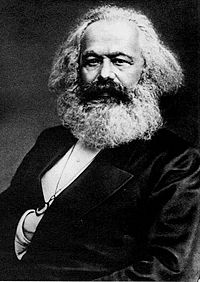CZ:Featured article/Current: Difference between revisions
imported>Chunbum Park mNo edit summary |
imported>Chunbum Park No edit summary |
||
| Line 1: | Line 1: | ||
== '''[[ | == '''[[Karl Marx]]''' == | ||
---- | ---- | ||
{{Image| | {{Image|Karl Marx.jpg|right|200px|Karl Marx.}} | ||
''' | '''Karl Marx''' (1818-1883) is generally thought of as the co-founder, with Friedrich Engels, of the political movement known as [[communism]]. He made historically significant contributions to the intellectual disciplines of philosophy, economics, politics and historicism. Of his many written contributions to those disciplines, the best-known is the 3-volume Das Kapital, and he was co-author, with Friedrich Engels, of the Communist Manifesto. Their slogan "workers of the world unite" became the rallying calls for revolutionary movements including Russia's Bolshevic Revolution of 1917 and the Chinese Revolution of 1949; and Marx's advocacy of "from each according to his ability, to each according to his need" has been the inspiration of communist parties throughout the world. | ||
== | ==Overview== | ||
Karl Marx underwent a transition from academic theoretician to political activist - leaving an influential legacy in both fields. As a | |||
student of [[philosophy]] he accepted the tenets of traditional [[humanism]], but he later developed his own interpretation in which religion is a response to hardship, and one that is destined to survive until its cause is removed. He sought an explanation for working class hardships in the theories of [[History of economic thought#Classical Economics|classical economics]] and developed his own analysis which concluded that [[capitalism]] deprives working people of all of the fruits of their labour beyond the amounts necessary for their subsistence. His analysis of historicism led him to the conclusion that capitalism contained the seeds of its own destruction, and that its overthrow would happen first where the development of capitalism was most advanced. His political theories were concerned with the processes by which capitalism could be replaced by a system governed by the principle of "from each according to his ability, to each according to his need". As a political activist, he played a major part in the promotion of [[communism]], and was a founder member of the Communist League (later to become the Communist International). His intellectual legacy was globally influential despite the development of a consensus among academic economists that his economic analysis was flawed. His political proposals were taken up and developed by Lenin and others, and were the inspiration of Russia's Bolshevic Revolution and of communist revolutions in China, Cuba and elsewhere. | |||
''[[Karl Marx|.... (read more)]]'' | |||
''[[ | |||
{| class="wikitable collapsible collapsed" style="width: 90%; float: center; margin: 0.5em 1em 0.8em 0px;" | {| class="wikitable collapsible collapsed" style="width: 90%; float: center; margin: 0.5em 1em 0.8em 0px;" | ||
|- | |- | ||
! style="text-align: center;" | [[ | ! style="text-align: center;" | [[Karl Marx#Footnotes and references|notes]] | ||
|- | |- | ||
| | | | ||
{{reflist|2}} | {{reflist|2}} | ||
|} | |} | ||
Revision as of 20:30, 5 April 2012
Karl Marx
Karl Marx (1818-1883) is generally thought of as the co-founder, with Friedrich Engels, of the political movement known as communism. He made historically significant contributions to the intellectual disciplines of philosophy, economics, politics and historicism. Of his many written contributions to those disciplines, the best-known is the 3-volume Das Kapital, and he was co-author, with Friedrich Engels, of the Communist Manifesto. Their slogan "workers of the world unite" became the rallying calls for revolutionary movements including Russia's Bolshevic Revolution of 1917 and the Chinese Revolution of 1949; and Marx's advocacy of "from each according to his ability, to each according to his need" has been the inspiration of communist parties throughout the world.
Overview
Karl Marx underwent a transition from academic theoretician to political activist - leaving an influential legacy in both fields. As a student of philosophy he accepted the tenets of traditional humanism, but he later developed his own interpretation in which religion is a response to hardship, and one that is destined to survive until its cause is removed. He sought an explanation for working class hardships in the theories of classical economics and developed his own analysis which concluded that capitalism deprives working people of all of the fruits of their labour beyond the amounts necessary for their subsistence. His analysis of historicism led him to the conclusion that capitalism contained the seeds of its own destruction, and that its overthrow would happen first where the development of capitalism was most advanced. His political theories were concerned with the processes by which capitalism could be replaced by a system governed by the principle of "from each according to his ability, to each according to his need". As a political activist, he played a major part in the promotion of communism, and was a founder member of the Communist League (later to become the Communist International). His intellectual legacy was globally influential despite the development of a consensus among academic economists that his economic analysis was flawed. His political proposals were taken up and developed by Lenin and others, and were the inspiration of Russia's Bolshevic Revolution and of communist revolutions in China, Cuba and elsewhere.
| notes |
|---|
